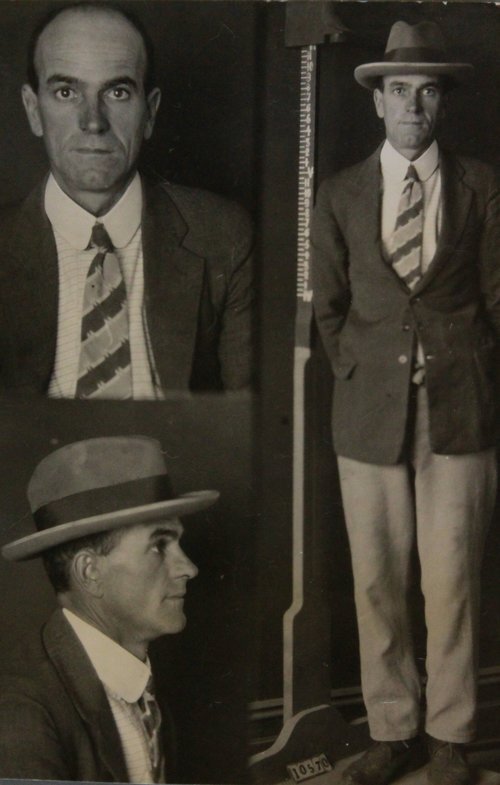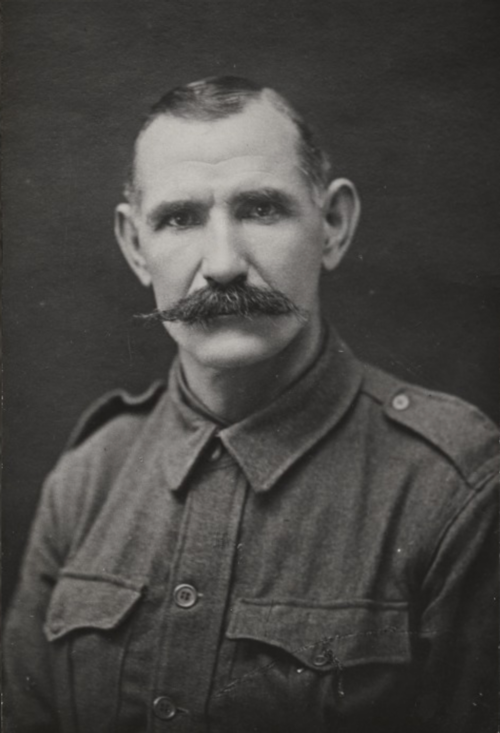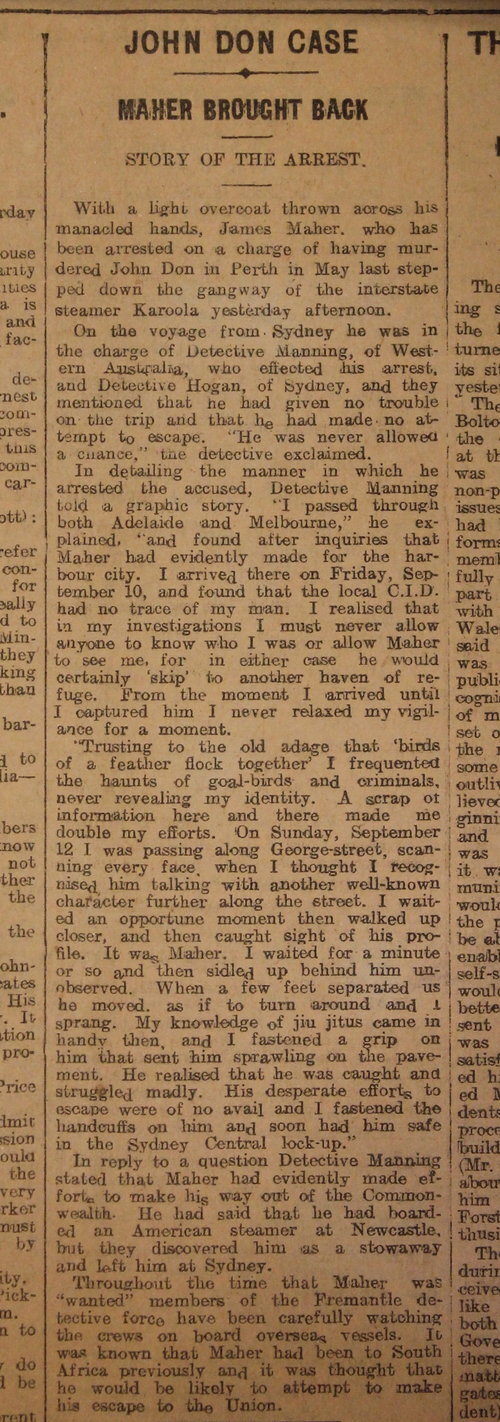doob
Legend Member
- Points
- 2,011
Perth sex workers help kill man!
LURED DOWN A LANE BY FECKLESS FLAPPERS AND DONE TO DEATH!
Wealthy Broome butcher Jack Don (45) spent 10 May 1920 in company, by appointment, with Eileen McDonald, a 22-year-old flapper and prostitute also known by the name ‘Joy’, and her 20-year-old colleague Elsie McLean, also known as Clare, described as the sort of hard-faced flapper who cannot be scared by anyone.They spent the day drinking whisky and joyriding around Guildford and Midland, visiting various hotels, and returned to Perth about 5pm that night. They then had a few more drinks at His Majesty’s Hotel, which the girls were known to frequent. There they were joined by Joy’s associate James Maher (24) who was described as a city parasite, racecourse thug, and near-vagrant ne’er-do-well who sometimes went by the name Walsh (his mother’s maiden name). The Kalgoorlie Miner of 10 August 1920 reported, “A large number of drinks were consumed, for all of which the deceased paid.” Despite this, none appeared to be drunk.
During the evening the men discussed their Great War service. It’s unlikely Maher admitted he’d embarked in June 1917 with reinforcements to the 11th Battalion but deserted at the first port, in Durban, South Africa. He was back in Perth in 1918, where he committed the first of his crimes under a different name.
Don never embarked, through no fault of his own, and showed Maher his AIF discharge papers which declared him permanently unfit due to injuries received when he was dragged underneath a car in February 1916. Don, at 179cm, was only slightly shorter than Maher’s 183cm, but he had weak knees, a frozen left shoulder from that old injury, and was nearly twice Maher’s age. As Maher sized up his partially-crippled prey, Don’s fate was likely sealed.
After another joyride and supper at the Strand Cafe in Hay Street, around midnight the four wandered, seemingly amiably, down Hay to King Street and St George’s Terrace. The women then disappeared down Banana (now Mercantile) Lane; a dark, narrow, private thoroughfare that went the length of Foy & Gibson’s factory from St George’s Terrace to The Esplanade, near the bottom of King Street.
On the edge of darkness near the top of the lane, each with a beer bottle in hand, Maher asked if he could borrow some of the money with which Don had been so free, all evening. Don refused and, hearing their voices raised, the girls returned before disappearing down the lane, once more.
Urging Don to follow the girls, Maher lured him down the lane, past the edge of darkness, where he pounced. He punched Don in the face and broke his nose, then smashed the beer bottles over Don’s head, fracturing his skull with a sickening crack. As Don collapsed to the ground Maher leant over, stole £105 (around $7,200 today) from his top pocket, and ran down Banana Lane.
Their trap sprung, the girls fled to the corner of Sherwood Lane and Bazaar Terrace (now Sherwood Court and the Esplanade), where Maher, filled with adrenaline, soon joined them. In front of the small brick house that stood where the Atlas Building now stands, he washed blood from his hands and spatter from his face in the river before weighing down his handkerchief with sand and throwing it in the water. He then showed the girls his bounty and threatened them not to “squeak” on him, or he’d “swing.”
The nefarious trio met up the next day in the Municipal Gardens in Subiaco and drove to the Nedlands Hotel where they had a couple of whiskeys. A witness reported he “had never seen a man pour as much whiskey down in one sitting. An average woman, or average man, would have been drunk, but they did not appear to be any the worse.”
After visiting several other suburban hotels in Cottesloe and Fremantle, Don still effectively footing the bill, Maher suggested they all catch that night’s train to Kalgoorlie. He gave Elsie £10 to purchase three first class tickets, and cautioned them to call him “Mr Anderson” while on board. They had a ‘sleeper’ with two berths; Maher took the top berth and the girls, the bottom. (The Truth of 16 October 1920 gleefully reporting “From that little piece of information it would appear that Commissioner Pope’s ... trains are not run on wowser principles.”)
In Boulder on 12 May Maher booked two hotel rooms in the Duke of York Hotel, where they spent the night; the girls in one room, he in the other. After they’d retired, Maher came in, and was acting strangely. After looking at the girls’ belongings on the dressing table, he left.
In the morning he came back to their room and said he was heading into Kalgoorlie to book them all train fares to Sydney. He promised to send a car for them, later that day, to take them to the station.
The realisation they had been abandoned took several hours. The promised car never came, then Eileen noticed her diamond ring, which had been on the dressing table overnight, was gone. She found it at the Federal Loan Office nearby, discovering it had been pawned for £4 that morning. Neither girl had money with which to either buy back the ring or obtain passage back to Perth.
Back at Banana Lane on the night of 10 May, Don managed to stagger back to the corner of St George’s Terrace and fell against a fence where he was found by Herbert Alwood. Covered in blood, he said, “look what they have done to me!”
Herbert called an ambulance and Don, who lapsed into unconsciousness as he was lifted onto the stretcher, was taken to Perth Public Hospital. He seemed to recover quite well initially until suddenly, nine days later, he collapsed and died from septic meningitis.
Maher was halfway to Adelaide when he heard of the arrest warrant out on him for the wilful murder of John Don. Desperate to escape, at Newcastle, NSW, he stowed away on a ship but was found and returned to shore, at Mosman.
In Sydney on 12 September Detective Manning caught and arrested Maher. He was brought back to Perth to answer to the charges in a sensational trial beginning on 7 October. The Truth of 16 October 1920 reported, “the space at the back of the court for the public ... was jammed full during the proceedings ... The crowd, almost wholly, stood throughout the day and, once in, never made any attempt to leave.”
In front of that packed courtroom, on 5 November Maher was found guilty and sentenced to ten years with hard labour. Chief Justice McMillan made it clear the root cause of the crime was drinking which had, in his opinion, caused a general increase in violence, in recent years.
Maher was released from prison on 19 May 1928 but within a year was caught red-handed relieving a drunken bushman of his wallet, watch and chain. Despite wild protestations of his innocence, he was sentenced to another four months with hard labour.
On his release Maher made his way to NSW where his crimes, all of a similar nature, continued. He died in Ryde, NSW, in 1966, aged 70.
By Shannon Lovelady
Story from Murder on the Swan
MAPPED LOCATION

James Maher’s mugshot. Courtesy State Records Office of Western Australia

Thomas John ‘Jack’ Don on enlistment, 1916. Courtesy State Library of Western Australia
View fullsize

View fullsize

Intersection of King and Hay looking north up King Street, 1927. Courtesy of the State Library of Western Australia (014467PD)
Source:
